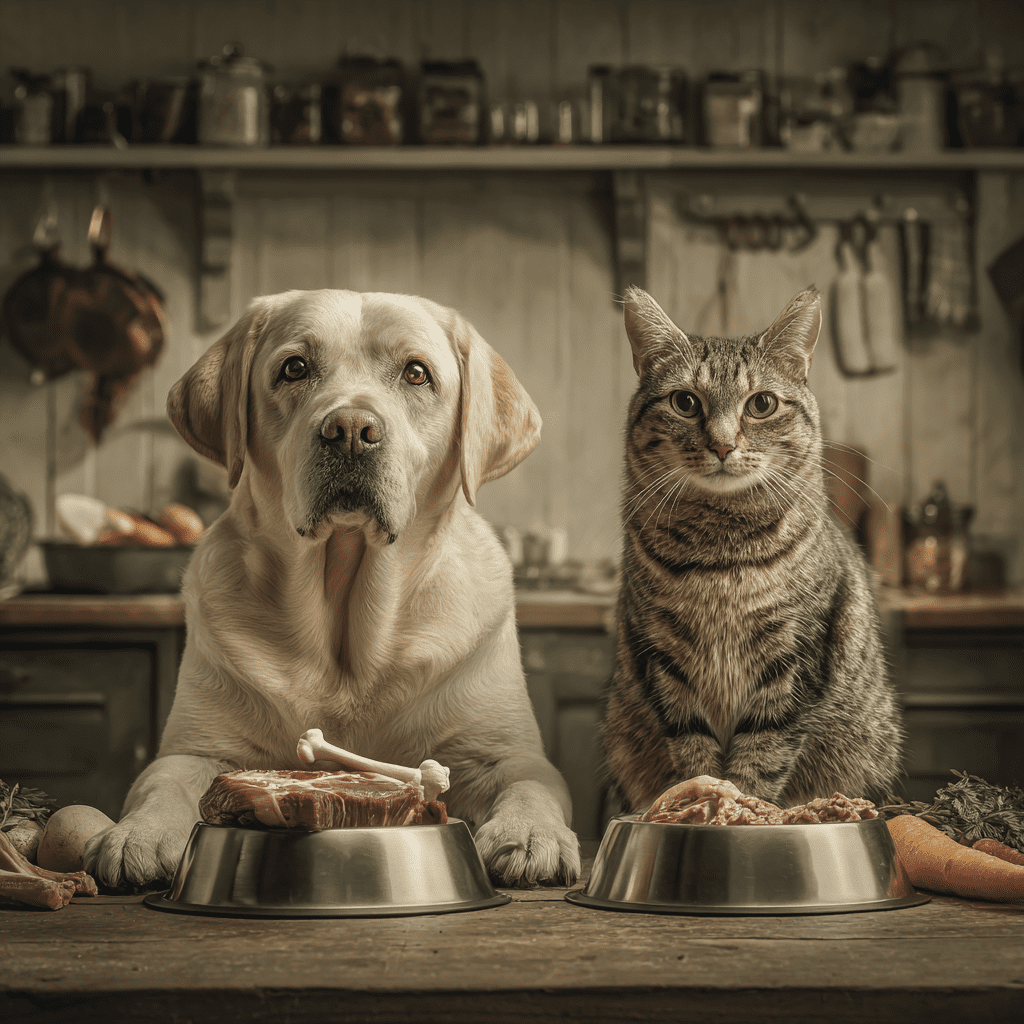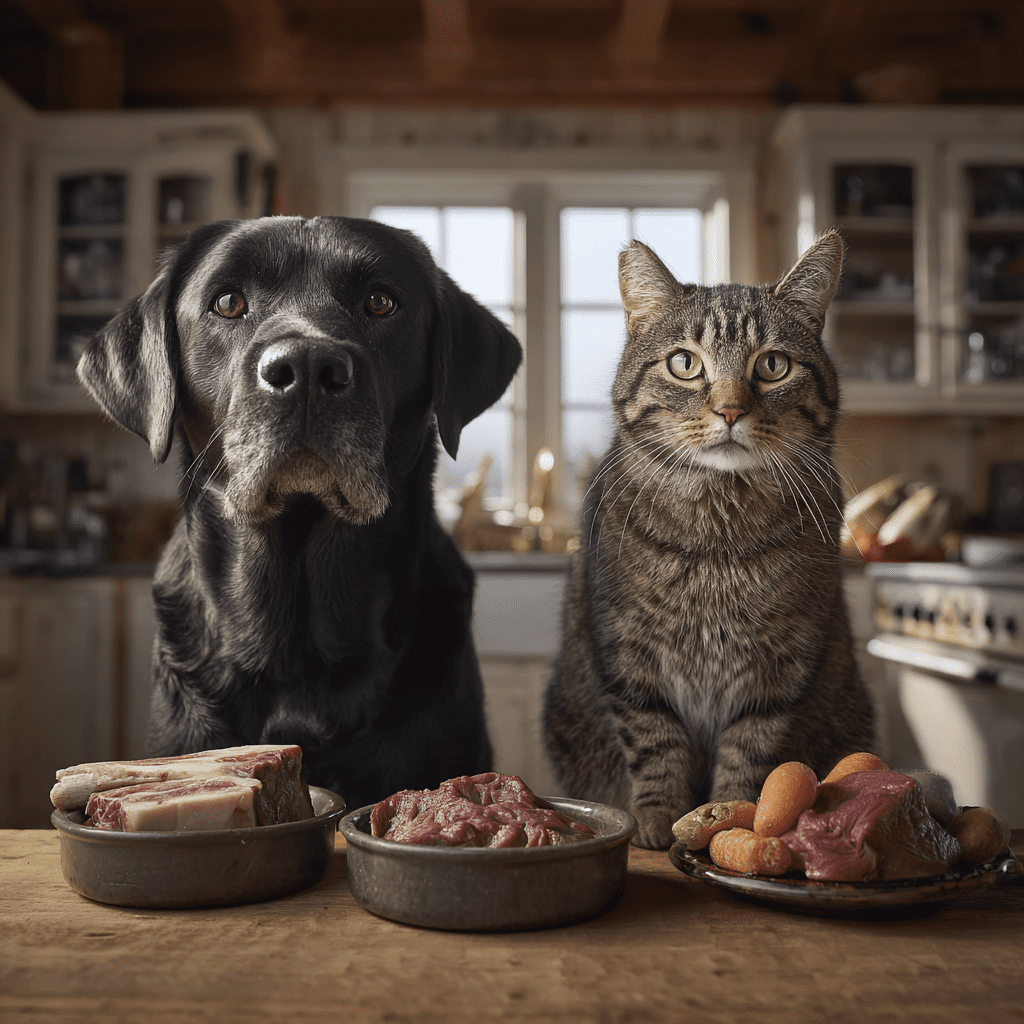Introduction: The Pet Food Debate
As pet owners, we want nothing but the best for our furry companions. From high-quality kibble to homemade meals, the choices are endless. But one debate has divided pet parents for years: Should pets eat a raw diet or a cooked diet?
Advocates of raw feeding argue it mimics what wild dogs and cats eat in nature, while those in favor of cooked diets stress food safety, digestibility, and balanced nutrition. With so much conflicting advice, how do you decide what’s right for your pet?
This blog breaks down the benefits, risks, and realities of raw vs. cooked diets, helping you make an informed choice.
Understanding Raw Diets for Pets
What Is a Raw Diet?
A raw diet typically includes:
- Raw muscle meat (beef, chicken, turkey, lamb, etc.)
- Organ meats (liver, heart, kidney)
- Raw bones
- Some vegetables, fruits, and supplements
It is sometimes referred to as the BARF diet (Biologically Appropriate Raw Food or Bones and Raw Food).
Claimed Benefits
- Healthier Coat and Skin – Many raw-fed pets develop shinier coats.
- Improved Dental Health – Chewing raw bones may reduce tartar.
- More Energy and Lean Muscle – High protein content supports active pets.
- Smaller, Firmer Stools – Raw diets are highly digestible.
Risks
- Bacterial Contamination: Raw meat can carry salmonella, E. coli, or listeria, which can affect both pets and humans.
- Nutritional Imbalance: Homemade raw diets often miss essential vitamins and minerals.
- Choking Hazards: Bones can splinter, causing injury.
- Weakened Pets at Risk: Puppies, kittens, or immunocompromised animals may not tolerate raw diets well.
Understanding Cooked Diets for Pets

What Is a Cooked Diet?
Cooked diets include meals prepared at home or commercially available cooked/frozen foods. These diets use cooked meats, vegetables, and grains to ensure food safety.
Benefits
- Food Safety – Cooking kills harmful bacteria and parasites.
- Easier Digestion – Cooking breaks down proteins and starches, making them easier to digest.
- Balanced Nutrition – Commercially cooked diets are formulated to meet AAFCO standards.
- Customization – Homemade cooked diets can be tailored to health conditions.
Risks
- Overcooking Nutrients: Heat can destroy vitamins like B-complex and some amino acids.
- Time-Consuming: Preparing balanced cooked meals at home requires planning and supplements.
- Quality Varies: Some commercial cooked foods may still use fillers or low-quality ingredients.
Comparing Raw and Cooked Diets
| Feature | Raw Diet | Cooked Diet |
|---|---|---|
| Food Safety | Risk of bacteria | Safer, bacteria killed |
| Digestibility | Highly digestible (if balanced) | Easier for sensitive pets |
| Dental Benefits | Raw bones may help | Requires brushing or dental chews |
| Convenience | Time-consuming, strict handling | More convenient (commercial options) |
| Cost | Expensive (meat-heavy) | Moderate to high |
| Suitability | Healthy adult pets | Pets of all ages, including seniors and sick pets |
Veterinary Insights: What Do Experts Say?
Most veterinarians remain cautious about raw diets due to food safety concerns. The FDA and CDC warn against raw feeding because of bacterial risks, not only to pets but also to humans in the household.
That said, some holistic vets support raw diets if they are properly formulated with supplements and handled hygienically.
Cooked diets are generally favored by veterinary nutritionists because they:
- Eliminate bacteria risks.
- Can be precisely formulated.
- Work for pets with health conditions.
Real-Life Stories
Bella the German Shepherd (Raw-Fed)
Bella’s owner noticed her coat became shinier and her energy levels increased after switching to a raw diet. However, Bella also developed digestive upset when bones weren’t prepared correctly. This highlights the importance of careful handling and professional guidance.
Whiskers the Cat (Cooked Diet)
Whiskers, a senior cat, struggled with kidney disease. His vet recommended a cooked, low-phosphorus diet. With tailored meals, Whiskers regained appetite and energy, showing how cooked diets can be life-changing for pets with medical conditions.
How to Safely Feed a Raw Diet
If you choose to feed raw:
- Work with a veterinary nutritionist to avoid deficiencies.
- Handle meat with strict hygiene (clean surfaces, wash hands).
- Freeze meat to kill parasites before serving.
- Never feed cooked bones (raw meaty bones only, with supervision).
How to Safely Feed a Cooked Diet
If you choose cooked:
- Use vet-approved recipes or commercially prepared cooked diets.
- Add supplements to replace nutrients lost during cooking.
- Avoid harmful foods (onions, garlic, grapes, chocolate).
- Ensure meals are portioned correctly to prevent obesity.
Which Is Best for Your Pet?
There’s no universal answer. The best diet depends on your pet’s age, health, and lifestyle.
- Raw Diet: May benefit healthy, active pets if done correctly with veterinary guidance.
- Cooked Diet: Safer, more reliable, and suitable for pets with health conditions or older pets.
👉 The golden rule: Always consult your veterinarian or a pet nutritionist before making drastic dietary changes.
Conclusion: Balance Over Buzzwords
The raw vs. cooked debate often sparks strong opinions, but the truth is that both diets can work—if properly managed. The key is balance, safety, and veterinary support.
Your dog or cat doesn’t need a trendy diet; they need one that keeps them healthy, active, and happy. Whether raw or cooked, the love and care you put into their meals make all the difference.
